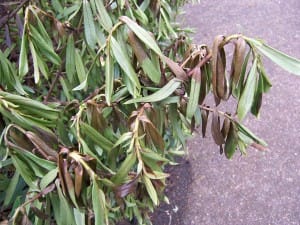Source(s): Stephen D Pettis
Cold injury, the damage caused to plants by freezing temperatures, may occur on the fruit, stems, leaves, trunk and roots. Water inside plant parts can freeze and expand, tearing cell walls and causing them to leak. This damage may go unnoticed until the plant fails to come out of dormancy in the spring.
There are three types of cold injury. The first is called a ‘burn’. Often cold damaged plant parts will become mushy and turn brown or black. Over time the damaged leaves or stems will dry out and appear to have been burned with a torch. Sunken areas may appear on branches and trunks and the bark may peel.
The second type of cold damage, desiccation, can be caused by winter winds. Cold air does not hold moisture like warm air (summer humidity and dry winter air) and can dehydrate plants if it is sustained for long periods of time. Leaves may dry up at the edges and eventually turn completely brown.
The third type of winter damage is wood splitting or ‘frost cracks’. This damage occurs on stems and branches. On particularly cold nights, water in the cells just beneath the bark of trees and shrubs freezes. When the sun hits these areas the next day, the water thaws quickly killing the cells and splitting the wood. Eventually, longitudinal (lengthwise) cracks may appear. Often these are not evident until the following summer.
Preventing cold damage to plants begins by planting plants that are native to our area or acclimated to the temperatures we experience. The USDA has created climatic zones based on average coldest temperatures for the regions of the US. Plants are categorized according to the areas in which they are hardy. Gardeners can choose plants that will perform in their area. For a map of the USDA hardiness zones they may visit the USDA website http://www.usna.usda.gov/Hardzone/ushzmap.html.
There are other ways to protect tender plants during the winter:
- Plant site selection can be crucial to winter hardiness of some plants. Planting under a tree canopy or near the southwest side of a home to maximize evening winter sun can protect plants.
- Plant nutrition can play a minor role in freezing. Maintaining proper fertility levels can lower the temperatures a plant can tolerate by 5 degrees.
- Windbreaks can be constructed or planted to block frigid winter winds.
- Plants can be covered with fabric on cold nights. Be sure to remove the fabric every day.
- Finally, watering plants keeps them hydrated and prevents plants from drying due to cold air and frozen soil.
Resource(s):
Center Publication Number: 161
- Herbicide Damaged Plants - September 24, 2013
- IPM in the Garden - September 24, 2013
- Leylands Get Really Big - September 24, 2013
